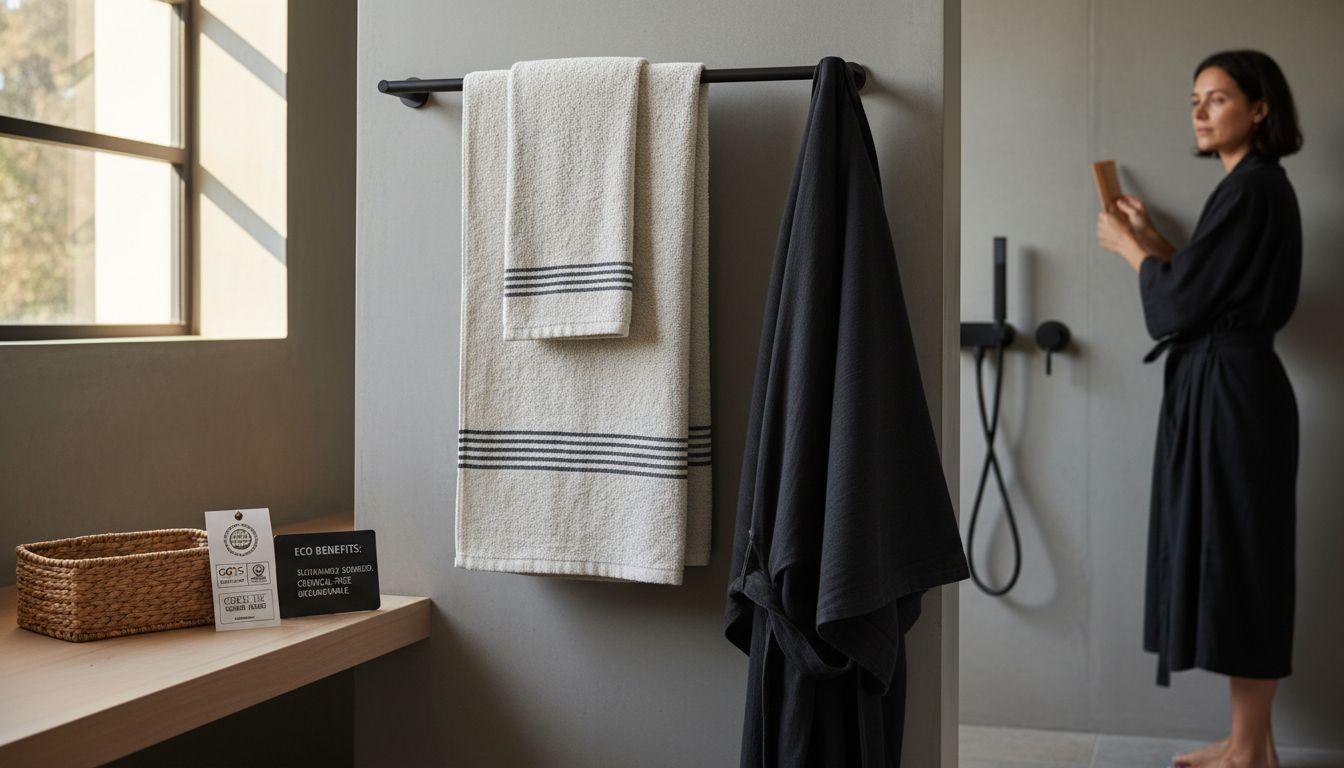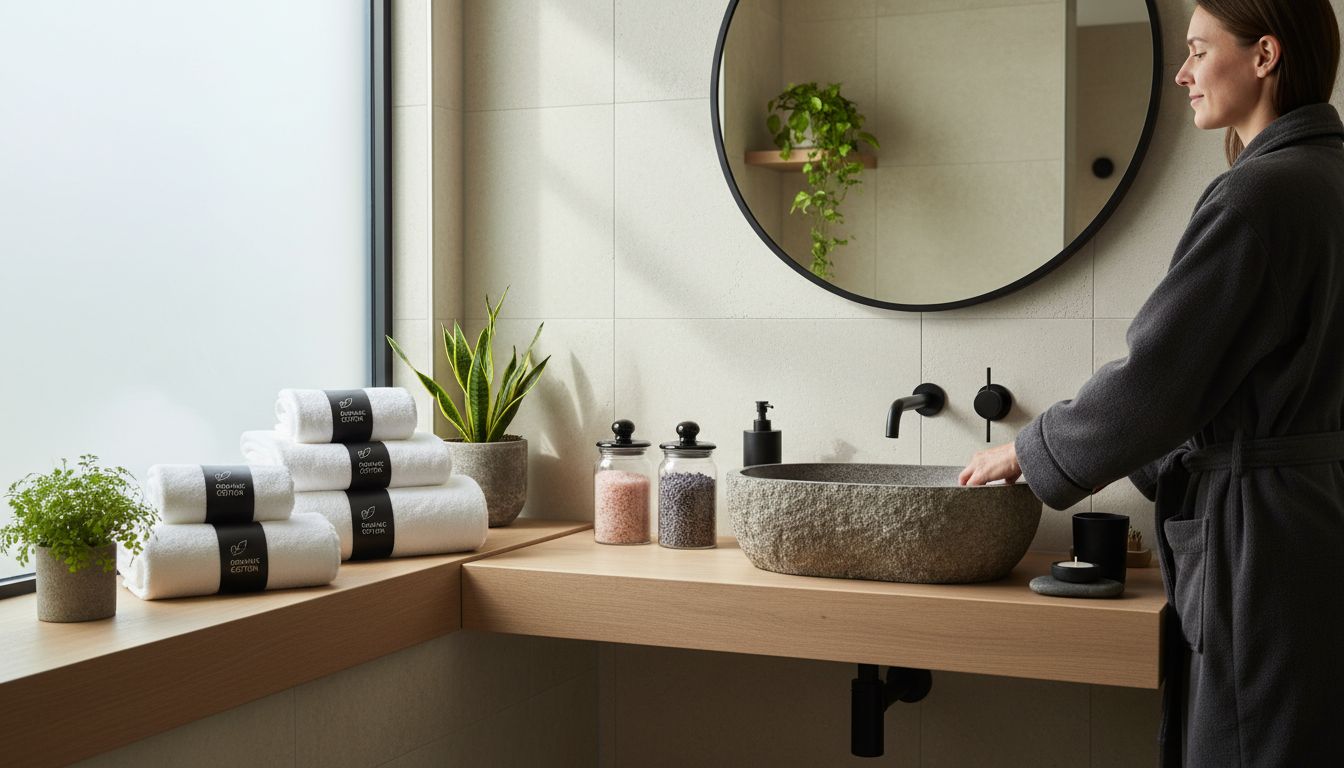Did you know that conventional textile manufacturing consumes up to 20,000 liters of water to produce just one kilogram of cotton? With growing concerns about resource depletion and environmental harm, many people now seek healthier, planet-friendly alternatives for essentials like bath linens. Learning about eco-friendly options helps you choose textiles that feel soft and luxurious while supporting sustainable, earth-conscious practices.
Table of Contents
- Eco-Friendly Bath Linens Defined and Debunked
- Types of Sustainable Fabrics and Materials
- Certifications and Standards for Eco Linens
- Benefits for Homes, Spas, and Hospitality
- How to Identify and Care for Green Linens
- Comparing Eco Linens With Conventional Options
Key Takeaways
| Point | Details |
|---|---|
| Sustainable Materials | Eco-friendly bath linens are made from organic cotton, hemp, and bamboo, reducing resource use and chemical processing. |
| Certifications Matter | Look for certifications like GOTS and Fairtrade to ensure ethical and environmentally responsible textile production. |
| Impact on Health | These linens lower allergen potential and exposure to harmful chemicals, promoting safer living spaces. |
| Comparative Advantages | Eco-friendly options feature lower carbon footprints and superior durability compared to conventional linens. |
Eco-Friendly Bath Linens Defined and Debunked
Eco-friendly bath linens represent a transformative approach to textile production that prioritizes both environmental sustainability and consumer comfort. According to Consumer Energy Center, these specialized linens are crafted from sustainable materials like organic cotton, hemp, and bamboo, which require significantly fewer resources and chemicals during cultivation and processing compared to traditional textile manufacturing methods.
The core characteristics of eco-friendly bath linens extend beyond simple material selection. As Sustainability Award explains, truly sustainable bath textiles are not just about the fabric itself, but the entire production ecosystem. These linens are biodegradable, produced with minimal environmental impact, and often follow strict ecological standards that protect both human and environmental health.
Key features that define eco-friendly bath linens include:
- Organic material sourcing
- Minimal chemical processing
- Lower water consumption during manufacturing
- Reduced carbon footprint
- Biodegradable and recyclable components
For those seeking luxurious yet responsible bath linens, understanding these nuanced details becomes crucial. Choosing bath towels goes beyond aesthetic preferences to embrace a holistic view of textile sustainability and personal wellness.
Types of Sustainable Fabrics and Materials
Sustainable fabrics are transforming the textile industry, offering environmentally conscious alternatives that reduce ecological impact while maintaining exceptional quality. According to Consumer Energy Center, these innovative materials include hemp, bamboo, and recycled polyester, each delivering unique benefits that extend far beyond traditional textile production.
The landscape of eco-friendly materials is rich and diverse. Sustainability Award highlights organic cotton, linen, and Tencel as premier examples of low-impact textiles known for their biodegradability and minimal environmental footprint. These materials represent a significant shift from conventional fabric production, prioritizing both planetary health and consumer comfort.
Key sustainable fabric types include:
Here’s a comparison of popular sustainable fabric types for bath linens:
| Fabric Type | Key Benefits | Sustainability Highlights |
|---|---|---|
| Hemp | Durable Low-allergen |
Minimal water use No pesticides |
| Bamboo | Naturally antimicrobial Soft feel |
Fast-regenerating Low resource needs |
| Organic Cotton | Gentle on skin High absorbency |
No harmful chemicals Less water usage |
| Recycled Polyester | Utilizes waste Strong fibers |
Reduces plastic pollution |
| Tencel/Lyocell | Silky texture Breathable |
Closed-loop production Biodegradable |
- Hemp: Extremely durable, requires minimal water, and grows rapidly without pesticides
- Bamboo: Highly renewable, quick-growing, and naturally antimicrobial
- Organic Cotton: Grown without harmful chemicals, using significantly less water
- Recycled Polyester: Reduces plastic waste by transforming existing materials
- Tencel/Lyocell: Produced through environmentally responsible processes with minimal waste
For those passionate about sustainable living, understanding these fabric options is crucial.
What Is Terry Cloth provides additional insights into how traditional and sustainable textile technologies intersect, helping consumers make more informed and responsible choices.
Certifications and Standards for Eco Linens
Navigating the world of eco-friendly textiles requires understanding the critical certification systems that validate environmental and ethical manufacturing practices. According to Ethical Consumer, certifications like the Global Organic Textile Standard (GOTS) and Fairtrade provide consumers with assurance that textiles meet stringent environmental and social responsibility criteria.
Beyond basic environmental considerations, these certifications represent a comprehensive approach to sustainable textile production. Sustain Your Style highlights the Global Recycled Standard (GRS) as a critical certification that ensures product traceability and verifies the authentic environmental impact of recycled material usage. These standards go far deeper than surface-level sustainability claims.

Key certifications for eco-friendly bath linens include:
- GOTS (Global Organic Textile Standard): Ensures organic fiber processing and ecological manufacturing
- Fairtrade Certification: Guarantees fair wages and safe working conditions
- Global Recycled Standard (GRS): Validates recycled content and responsible production
- OEKO-TEX Standard 100: Confirms textile safety and chemical-free processing
- Cradle to Cradle Certification: Evaluates product sustainability across entire lifecycle
For those seeking deeper insights into textile standards, Linen Safety Standards provides comprehensive guidance on understanding and interpreting these complex certification systems.
Benefits for Homes, Spas, and Hospitality
Eco-friendly bath linens are revolutionizing comfort and sustainability across multiple environments, from personal homes to professional hospitality settings. According to Kapatex, these innovative textiles offer enhanced softness, superior absorbency, and remarkable durability that meets the demanding needs of diverse spaces.
Green Choices highlights the additional advantages of sustainable fabrics like bamboo and hemp, which provide natural antibacterial properties while significantly reducing chemical usage. These inherent qualities make eco-friendly bath linens an exceptional choice for environments prioritizing health, wellness, and environmental responsibility.
Key benefits across different settings include:
- Homes: Increased comfort, reduced environmental footprint, and safer textile exposure
- Spas: Enhanced guest experience with premium, chemical-free materials
- Hospitality: Improved sustainability credentials and guest satisfaction
- Healthcare Facilities: Reduced allergen potential and improved hygiene standards
- Wellness Centers: Alignment with holistic health and environmental wellness principles
For those seeking to elevate their spaces with sustainable luxury, Luxury Spa Amenities offers insights into creating transformative environments that prioritize both comfort and conscientiousness.
How to Identify and Care for Green Linens
Identifying truly eco-friendly bath linens requires a discerning eye and understanding of sustainable textile markers. Green Choices recommends focusing on specific certifications like GOTS (Global Organic Textile Standard) and selecting materials such as organic cotton and bamboo as clear indicators of genuine environmental commitment.
Sustain Your Style emphasizes the critical importance of proper care to maintain the ecological integrity of sustainable fabrics. Gentle handling becomes paramount, with recommendations including using mild, eco-friendly detergents and preferring air drying to preserve the fabric’s natural properties and reduce environmental impact.
Key strategies for identifying and maintaining green linens include:
- Certification Check: Look for GOTS, Fairtrade, or Global Recycled Standard labels
- Material Inspection: Prioritize organic cotton, hemp, and bamboo textiles
- Washing Techniques: Use cold water and phosphate-free, biodegradable detergents
- Drying Methods: Air dry when possible to reduce energy consumption
- Storage: Keep in cool, dry spaces away from direct sunlight to prevent fabric degradation
For those seeking additional guidance on maintaining premium textiles, Linen Safety Standards provides comprehensive insights into textile care and preservation.
Comparing Eco Linens With Conventional Options
The landscape of textile production reveals stark differences between eco-friendly linens and conventional alternatives. According to We Do, eco-friendly linens crafted from organic cotton and hemp represent a revolutionary approach, offering biodegradable materials with substantially lower environmental impact compared to traditional fabric manufacturing.
Sustain Your Style highlights the critical distinctions in production methodologies, emphasizing that conventional fabrics typically involve intensive resource consumption and harsh chemical treatments. In contrast, sustainable options prioritize environmental and social responsibility throughout their entire lifecycle.
Key comparative aspects between eco and conventional linens include:
- Resource Usage: Eco linens require significantly less water and energy
- Chemical Processing: Sustainable fabrics minimize toxic chemical treatments
- Longevity: Organic materials often demonstrate superior durability
- Environmental Impact: Reduced carbon footprint and biodegradability
- Health Considerations: Lower allergen potential and reduced chemical exposure
Those interested in exploring premium textile options might find Hand Towels with Scallop Piping an excellent example of sustainable luxury that bridges style and environmental consciousness.
![]()
Elevate Your Everyday Comfort with Truly Eco-Friendly Bath Linens
Choosing eco-friendly bath linens means embracing sustainability without sacrificing luxury. If you are looking to reduce your environmental impact while enjoying soft, durable towels and robes, Lotus Linen offers premium options made with care for both your skin and the planet. Discover the gentle touch of organic cotton and the elegant details of our Scallop Piping Towels | Luxury Cotton Bath Sets, crafted to combine beauty and responsibility.

Experience bath linens designed for those who value comfort and conscious living. Visit Lotus Linen today to explore our full collection including Lightweight Cotton Kimono Bathrobes for Men. Upgrade your home with luxurious, sustainable textiles that nurture your well-being and honor the environment. Act now to bring eco-friendly elegance to your daily routine.
Frequently Asked Questions
What materials are typically used in eco-friendly bath linens?
Eco-friendly bath linens are usually made from sustainable materials like organic cotton, hemp, bamboo, and recycled polyester, which require fewer resources and chemicals during production compared to traditional fabrics.
How can I identify eco-friendly bath linens?
To identify eco-friendly bath linens, look for certifications such as GOTS (Global Organic Textile Standard), Fairtrade, or OEKO-TEX. Additionally, prioritize fabrics like organic cotton, hemp, and bamboo known for their eco-friendly properties.
What are the benefits of using eco-friendly bath linens?
Eco-friendly bath linens offer several benefits, including reduced environmental impact, lower allergen potential, enhanced comfort, and superior absorbency. They also promote health and wellness by providing safe, chemical-free materials.
How should I care for eco-friendly bath linens to maintain their quality?
Care for eco-friendly bath linens by using cold water washes with phosphate-free, biodegradable detergents, air drying when possible, and storing them in a cool, dry space. Avoid harsh chemicals to preserve their natural properties.
